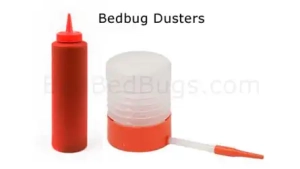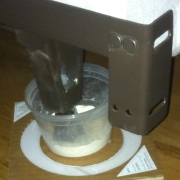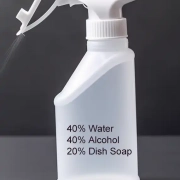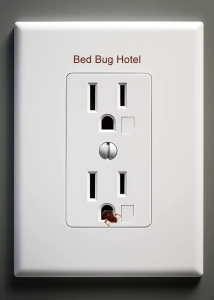Bed Bug Dust: DIY Pest Control
Bed bug powder is simply food grade Diatomaceous Earth which is ground fossilized algae-like plants called diatoms, which is nontoxic. When placed into a duster such as a plastic ketchup container and gently blown into suspected areas, it effectively kills bed bugs (and works on fleas & ants as well).
There are two types of diatomaceous earth (DE): food grade and pool grade; Pool grade is dangerous to breathe. Food Grade DE is what farmers use to keep insects out of their grain. There are claims that you can breathe in as much food grade DE as you like and not risk lung damage, but I would NOT chance it (ask your doctor when in doubt). Always wear an appropriate mask.
The absorbent quality may also cause significant drying of your hands, so play it safe, wear a face mask and gloves when spraying.
Other names used for DE are “bed bug dust,” “mother earth,” or “fossil shell flour”; again, it’s the food grade DE that they are talking about.
The Powder (DE)
Mother Nature’s natural bed bug killer is a white power containing microscopic razor sharp edges that damage the bug’s protective covering. It then absorbs lipids from the waxy outer layer of a bug’s exoskeleton, causing dehydration.
A duster forces the power into nesting areas. Once the bed bugs come in contact with the powder, they are as good as dead!
So does it work? Yes, according to the experts at Purdue University, pest exterminators, and numerous visitors to this website over the last decade, but you must retreat weeks later (and to play it safe, a 3rd application as well)!
Need help figuring out where to spray? No worries, we will show you exactly where to find them :)
How Much Bed Bug Dust Cost?
Ah, the big question! Can you believe a bag of bed bug dust only runs about $12 for a 2-pound bag, and you can buy it from almost any local feed and supply store? You can see why pest control companies would rather you not know about it :)
Some companies sell repackaged versions of this, jack the price way up, and claim their product is better than what you can buy yourself. Read the label to learn the truth :)
How Long Before They Die?
Changlu Wang, Timothy Gibb, and Gary W. Bennett from Purdue University did an excellent study on the cost and effectiveness of using Diatomaceous earth on infested apartments containing thousands of bed bugs. The main message of the study was that bed bug dust works!
 Several treatment methods were used, such as a mattress encasement and steam. They also made sure to put the legs of chairs, sofas, nightstands, and anything else into bed bug interceptor traps like that shown in the image above. Here is how to make a bed bug trap.
Several treatment methods were used, such as a mattress encasement and steam. They also made sure to put the legs of chairs, sofas, nightstands, and anything else into bed bug interceptor traps like that shown in the image above. Here is how to make a bed bug trap.
It took ten weeks, and they re-steamed and reapplied the powder when necessary; because death is not immediate, the females may be able to deposit eggs that will hatch and become active. It is these hatchlings (instars) that you need to stay on top of.
The study found that bug interceptors trapped an average of 219 bed bugs per apartment and were a valuable part of the treatment program.
In the study, 16 equally infested units were selected, and half the units were 100% bug-free while the remaining units were 98% free; another application would likely have taken care of the rest, but because the study was limited to 10 weeks, we won’t know for sure. Total extermination costs averaged $470, but this amount can be reduced using generic products, such as:
- A dust mite mattress encasement rather than one made for bed bugs (they are the same, but you pay more for one)
- Using food grade DE found at feed and supply stores rather than something with a catchy “green” label.
- Making your own bed bug climb-up protectors / interceptors rather than buying commercial traps.
- Buying a generic steamer (or renting) rather than one made for infestations (make sure the heat & attachments are the same).
We have plenty of success stories using these methods; remember that these pests will not die overnight; it can take a few months to treat a large infestation properly, but don’t give up – you will succeed!
Visitors have successfully eliminated bed bugs using this same method, and the truth is, you’ll have to do most of the prep work if you were to hire a professional exterminator.
How to Make Bed Bug Powder
 The Bed Bug Killer: This solution, which you put into a spray bottle, will help to kill them on contact. A mixture of %40 alcohol (ethyl alcohol works), %40 water, and %20 dish soap can kill them on contact. Be careful what you spray this mixture on, and do a small test area first. For example, do NOT spray any liquid into electrical outlets, etc.
The Bed Bug Killer: This solution, which you put into a spray bottle, will help to kill them on contact. A mixture of %40 alcohol (ethyl alcohol works), %40 water, and %20 dish soap can kill them on contact. Be careful what you spray this mixture on, and do a small test area first. For example, do NOT spray any liquid into electrical outlets, etc.
The Liquid Bed Bug Powder: This 2nd solution, which you also place in a spray bottle, is used if the 3rd option below creates too much dust in the air. A mixture of 2 heaping tablespoons of diatomaceous earth to 32oz water.
The mixture of water and powder is for those that cannot tolerate breathing in straight dust; this spray will not be effective when wet, but once the water evaporates, it leaves only the dust and will become an effective insecticide.
The Bed Bug Power: This 3rd solution is simply a duster filled with powder (DE).
Dry or wet, play it safe, and always wear a mask when spraying.
You’ll also need a powerful vacuum with attachments you’ll use for sucking loose bugs out of their hiding places.
This do-it-yourself bed bug spray is nontoxic.
Know where to spray
Bed bugs love to hide and do a great job at it! Victims have gone months without signs only to discover that an infestation was right next to them.
Use our inspection checklist to know where to spray your all natural mixtures.
What is nice about this type of pest control is that should the bugs retreat to other areas, like the apartment next door, they will eventually die from dehydration after having come in contact with the dust – it only requires a little to kill the bug.
Make sure you have cleaned everything but BE CAREFUL not to get the electrical outlets wet or use conductive attachments!
How to Spray the Powder
It’s time to have fun! Spray the mixture on any bed bugs you see to kill them on contact. Use a flashlight and look for signs of bugs, such as eggs and stains (the stains looks like someone dotted the area with a black marker). If you find eggs (they look like tiny rice, use a fine tooth comb or masking tape to collect them. Place any eggs in a zip-lock bag with a bit of dust and immediately place them in your outside trash container. Vacuum up the fallout.
You’ll want to spray the bed bug powder into all the cracks and crevices you vacuumed – a light dusting will do fine.
Now use your duster (filled with food-grade diatomaceous earth) and dust into the bottom of the mattress box spring – you can make a small hole in the fabric or dust through the fabric to prevent damage. I prefer making a small incision and getting it into the box spring rather than having a film of white powder on the outside. Again, play it safe and wear a dust mask and gloves.
Wait 30 days and spray again!
The most important part of this process is repetition – do it again a few weeks later to be sure the powder stays effective.
